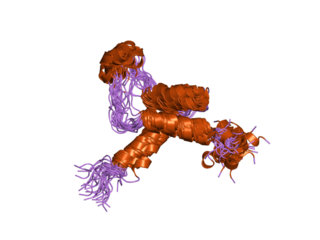Transcription factor Sp1, also known as specificity protein 1* is a protein that in humans is encoded by the SP1 gene. [5]
Transcription factor Sp1, also known as specificity protein 1* is a protein that in humans is encoded by the SP1 gene. [5]
The protein encoded by this gene is a zinc finger transcription factor that binds to GC-rich motifs of many promoters. The encoded protein is involved in many cellular processes, including cell differentiation, cell growth, apoptosis, immune responses, response to DNA damage, and chromatin remodeling. Post-translational modifications such as phosphorylation, acetylation, O-GlcNAcylation, and proteolytic processing significantly affect the activity of this protein, which can be an activator or a repressor. [5]
In the SV40 virus, Sp1 binds to the GC boxes in the regulatory region (RR) of the genome.
SP1 belongs to the Sp/KLF family of transcription factors. The protein is 785 amino acids long, with a molecular weight of 81 kDa. The SP1 transcription factor contains two glutamine-rich activation domains at its N-terminus that are believed to be necessary for promoter trans-activation. [6] SP1 most notably contains three zinc finger protein motifs at its C-terminus, by which it binds directly to DNA and allows for interaction of the protein with other transcriptional regulators. Its zinc fingers are of the Cys2/His2 type and bind the consensus sequence 5'-(G/T)GGGCGG(G/A)(G/A)(C/T)-3' (GC box element). Some 12,000 SP-1 binding sites are found in the human genome. [7]
Sp1 has been used as a control protein to compare with when studying the increase or decrease of the aryl hydrocarbon receptor and/or the estrogen receptor, since it binds to both and generally remains at a relatively constant level. [8]
Recently, a putative promoter region in FTMT, and positive regulators {SP1, cAMP response element-binding protein (CREB), and Ying Yang 1 (YY1)] and negative regulators [GATA2, forkhead box protein A1 (FoxA1), and CCAAT enhancer-binding protein b (C/EBPb)] of FTMT transcription have been identified (Guaraldo et al, 2016).The effect of DFP on the DNA-binding activity of these regulators to the FTMT promoter was examined using chromatin immunoprecipitation (ChIP) assay. Among the regulators, only SP1 displayed significantly increased DNA- binding activity following DFP treatment in a dose-dependent manner. SP1 knockdown by siRNA abolished the DFP-induced increase in the mRNA levels of FTMT, indicating SP1-mediated regulation of FTMT expression in the presence of DFP. Treatment with Deferiprone increased the expression of cytoplasmic and nuclear SP1 with predominant localization in the nucleus. [9]
Plicamycin, an antineoplastic antibiotic produced by Streptomyces plicatus , and Withaferin A, a steroidal lactone from Withania somnifera plant are known to inhibit Sp1 transcription factor. [10] [11]
miR-375-5p microRNA significantly decreased expression of SP1 and YAP1 in colorectal cancer cells. SP1 and YAP1 mRNAs are direct targets of miR-375-5p. [12]
Sp1 transcription factor has been shown to interact with:

Transcription factor p65 also known as nuclear factor NF-kappa-B p65 subunit is a protein that in humans is encoded by the RELA gene.

TEAD2, together with TEAD1, defines a novel family of transcription factors, the TEAD family, highly conserved through evolution. TEAD proteins were notably found in Drosophila (Scalloped), C. elegans, S. cerevisiae and A. nidulans. TEAD2 has been less studied than TEAD1 but a few studies revealed its role during development.

CAMP responsive element binding protein 1, also known as CREB-1, is a protein that in humans is encoded by the CREB1 gene. This protein binds the cAMP response element, a DNA nucleotide sequence present in many viral and cellular promoters. The binding of CREB1 stimulates transcription.

Cyclic AMP-dependent transcription factor ATF-3 is a protein that, in humans, is encoded by the ATF3 gene.

Myocyte-specific enhancer factor 2C also known as MADS box transcription enhancer factor 2, polypeptide C is a protein that in humans is encoded by the MEF2C gene. MEF2C is a transcription factor in the Mef2 family.

Pre-B-cell leukemia transcription factor 1 is a protein that in humans is encoded by the PBX1 gene.

Transcription factor E2F3 is a protein that in humans is encoded by the E2F3 gene.

GA-binding protein alpha chain is a protein that in humans is encoded by the GABPA gene.

COUP-TF1 also known as NR2F1 is a protein that in humans is encoded by the NR2F1 gene. This protein is a member of nuclear hormone receptor family of steroid hormone receptors.

Host cell factor 1, also known as VP16-accessory protein, is a protein that in humans is encoded by the HCFC1 gene.

Recombination signal binding protein for immunoglobulin kappa J region is a protein that in humans is encoded by the RBPJ gene.

General transcription factor II-I is a protein that in humans is encoded by the GTF2I gene.

Myocyte-specific enhancer factor 2D is a protein that in humans is encoded by the MEF2D gene.

Zinc finger protein 148 is a protein that in humans is encoded by the ZNF148 gene.

Alpha-globin transcription factor CP2 is a protein that in humans is encoded by the TFCP2 gene.

Transcriptional enhancer factor TEF-1 also known as TEA domain family member 1 (TEAD1) and transcription factor 13 (TCF-13) is a protein that in humans is encoded by the TEAD1 gene. TEAD1 was the first member of the TEAD family of transcription factors to be identified.

Krueppel-like factor 11 is a protein that in humans is encoded by the KLF11 gene.

Transcription factor GATA-5 is a protein that in humans is encoded by the GATA5 gene.

Nuclear factor, interleukin 3 regulated, also known as NFIL3 or E4BP4 is a protein which in humans is encoded by the NFIL3 gene.

General transcription factor IIE subunit 2 (GTF2E2), also known as transcription initiation factor IIE subunit beta (TFIIE-beta), is a protein that in humans is encoded by the GTF2E2 gene.
This article incorporates text from the United States National Library of Medicine, which is in the public domain.